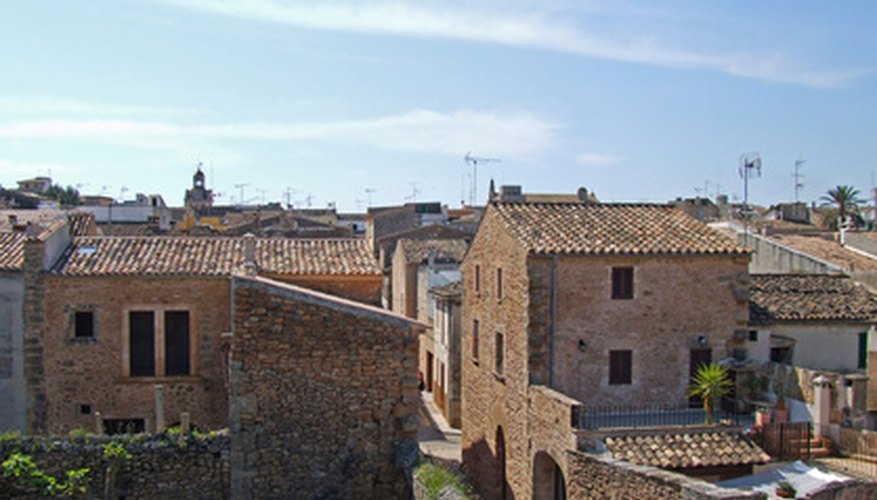Whether you have a Spanish villa with endless acres of land to plant, a rooftop terrace or a small balcony, Spain is a great place to grow your own fruits and vegetables. Before you plant, be sure to take into account the local climate, as well as fruits and vegetables native to the area. So grab a spade and reap the rewards of a job well done in fresh produce.
Do your research. Get informed online or at your local library or bookstore, about the weather and conditions in the region where you plan to plant your Spanish garden. In mountainous regions, in the North, and on the Western coast, winters are colder and wetter than on the Mediterranean coast, Southern Spain and Spain's Islands. For good growing conditions year-round, the Mediterranean and Southern coastal regions are best.
- Whether you have a Spanish villa with endless acres of land to plant, a rooftop terrace or a small balcony, Spain is a great place to grow your own fruits and vegetables.
- For good growing conditions year-round, the Mediterranean and Southern coastal regions are best.
Think about what you would like to plant. Research the conditions under which the fruits and vegetables you prefer grow best. In the coastal areas of Spain that have a subtropical climate, exotic fruits like avocados, bananas and mangoes can be grown, and figs, grapes, and a full range of citrus fruits are grown up and down the Mediterranean coast. Write down the names of the plants in English for your reference, and in Spanish for easy local purchase.
Don't hesitate to get advice from an expert. If neighbours, friends or family that live in the area have successfully planted a Spanish fruit and vegetable garden, ask them what has worked for them in terms of layout, which plants to grow, when to plant and when to harvest.
- Think about what you would like to plant.
- If neighbours, friends or family that live in the area have successfully planted a Spanish fruit and vegetable garden, ask them what has worked for them in terms of layout, which plants to grow, when to plant and when to harvest.
Think carefully about budget. Buying larger trees and mature plants can mean faster crops, but is also much more expensive. Growing your fruit trees and vegetable plants from seed can be difficult and time consuming. Set a budget for your garden and stick to it.
Measure your space and look at the space requirements for different vegetables and fruit trees. Even the smallest balcony or terrace garden should house a perpetual lemon tree, some tomato and onion plants and fresh herbs for authentic Spanish cooking.
Lay out your space on paper, always considering the sunlight, potential growth and moisture each plant needs. Don't forget, in Spain, especially in the subtropical coastal regions, some plants can get very large. If you're planting in areas where fruit trees and vegetable crops might need to be moved periodically because of varying weather conditions, consider planting them in containers or pots on wheels to move them as necessary.
Once you have your fruits and vegetables selected, always keeping in mind which plants grow best during which seasons in your area of Spain, and your space measured and laid out, change into old clothes that you don't mind staining, get on your garden gloves and start planting.
Plant citrus trees such as lemons, oranges and grapefruits in any size garden; they grow well everywhere in Spain, but they need very well-drained soil. Almond trees are small with a pretty winter floral display and grow well in Spain, but you will need two trees to harvest almonds.
- Measure your space and look at the space requirements for different vegetables and fruit trees.
- Almond trees are small with a pretty winter floral display and grow well in Spain, but you will need two trees to harvest almonds.
If you have limited space, buy dwarf fruit trees whenever possible. Pepper plants and fresh herbs are great for cooking and easy to maintain. Grapes, figs, pomegranates, plums and cherries grow well in Mediterranean coastal areas and can be left to ripen on trees and vines.
- If you have limited space, buy dwarf fruit trees whenever possible.
- Grapes, figs, pomegranates, plums and cherries grow well in Mediterranean coastal areas and can be left to ripen on trees and vines.
Plant lettuce and leaf vegetables in early spring. Summer heat in Spain tends to wilt leaf crops. Plant cabbage and cauliflower in late winter for early spring harvesting in most parts of Spain. Olives grow well in Southern Spain and Mediterranean coastal areas, but keep in mind that harvesting and preparing olives is hard work. Dry, freeze and can excess produce for later use.
Save fruit trees from winter frost in Northern Spain and mountainous areas by planting them in movable planters and moving them to protected areas closer to the house when cold weather hits.
